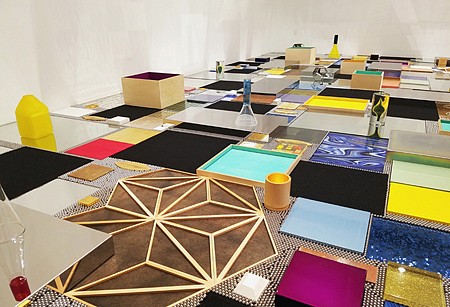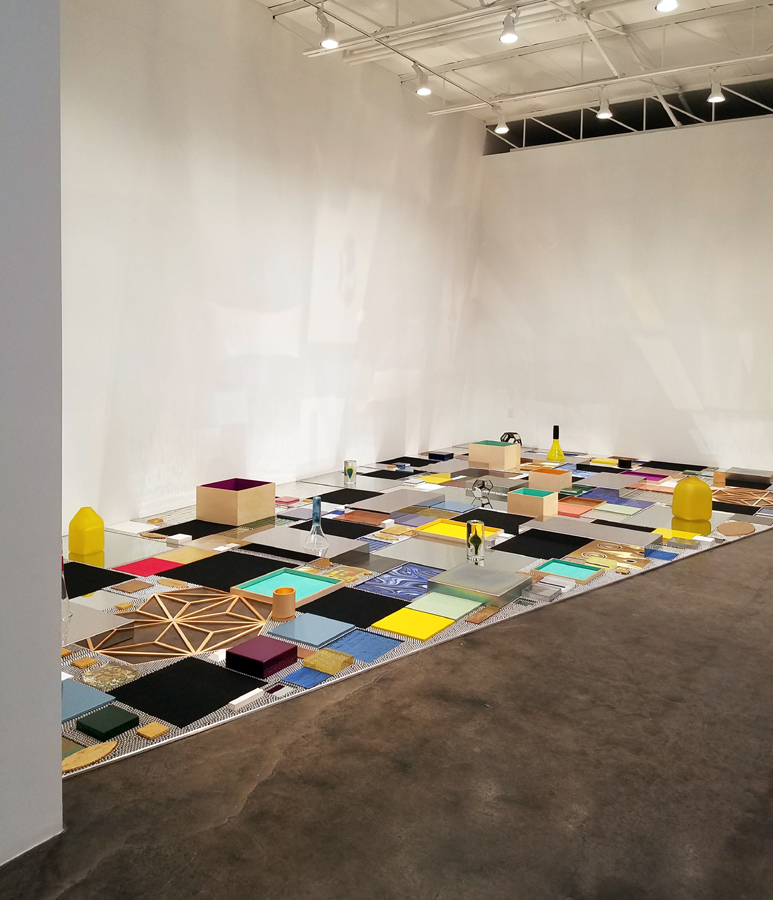
REVIEW: Margo Sawyer in Glasstire
January 11, 2018 - Christina Rees
Crowded public art openings at galleries are not ideal for spending quality time with art, but sometimes you take what you can get.
And sometimes a work will sneak up on you and lock you in for a surprising moment, despite the distractions.
When a new season kicks in, like it has in this post-holiday week, you may find yourself at openings while also vowing (to yourself, to an artist, to the gallerist) that you’ll be back on a quieter day to take another look. How many times have we thought and said this and not followed up? We mean to. But then the next round of openings happens the following weekend, and then the next, and obligations pile up while time is squeezed.
On a personal note, it can take me days if not weeks to shake off late December’s near-total expulsion of art from one’s life. Hitting a bunch of galleries last Saturday evening was bracing, like a cold-water plunge. My last big dive into looking at art had happened only three weeks earlier, and that felt like… last year.
One of my stops on Saturday was Holly Johnson. I knew the two shows opening there were David Aylsworth (always solid) and Margo Sawyer (ditto), and the last thing I expected was to go still for a moment. But Sawyer’s installation stopped me. I think the reasons for this are both simple and complicated, and have to do with how our perceptions of time and space can shift considerably over the course of seconds. What speaks to the quiet strength of the piece is that I had no intention of engaging with it (I’ll just come back later), and then, like a shimmering harbor dock beckoning an errant boat, it pulled me in.
The first time I walked through her room, the distraction of being out and running into people and starting new conversations kept me from doing anything more than run my eyes over it, back and forth, back and forth while chatting — ‘yadda yadda, Happy New Year to you too, how was your Christmas, what are you working on’ — but I was already a bit charmed; it was a very nice thing to look at while I stood by the far wall. I could hear Diana Vreeland’s voice in my head: The eye has to travel. Boy is this installation built for eye travel.
Sawyer has been doing variations on her Elysian Room since the ‘90s, but it’s not the work I’m familiar with. Like many, my Sawyer knowledge is of her clever and colorful three-dimensional Tetris-like public artworks that hang on walls or are walls themselves — we encounter them frequently enough, and they’re impressive, but also like old friends at this point.
To be honest, when I walked into that second room where her installation takes up roughly half the floor space, I had to do a double-take on her name on the wall, because I didn’t link it to her. But it is, of course, completely of a piece with her oeuvre. The way Sawyer’ work bends, layers, and generates new space (and therefore light), like architecture, is the point of it. And I think her expansion on this exercise — which the floor installation is both physically and conceptually — is a marvelous if unpretentious centering of her concerns. I think this work is more personally Sawyer than the Sawyers we normally see out there.
When I mention the time-space perceptual shift, I do mean the work itself, along with what it can do for us, the viewer. So what I really mean is what happened for me five minutes later, when I stopped to watch two school-age kids studying the work with their mom. I liked how hooked they were by it, how they were finding something new to comment on every ten seconds or so, and I realized that to get a couple of nine-year olds to treat art like it was the best kind of video game is a bit of a coup, especially considering that the very Zen quality of the work is the opposite of frenetic. So I blocked out the room chatter and… let my eye travel.
Sawyer debuted this kind of installation years ago, when in residence in Japan, and she revisits it every so often. And of course it is incredibly evocative of Buddhist notions of contemplation, meditation, deliberateness — that delicious push-pull of an active mind that’s also deeply relaxed. That is exactly what Sawyer’s installation achieves once you give it chance — even in a loud, crowded room on a busy Saturday night. For a few luxurious moments in that space, I fell into the kind of glittering meditative trance, sans drugs or booze, that offered profound respite from the anxiety that comes with art-scene re-entry. Time slowed, my sense of light and the perimeters of the room shifted, my sense of urgency relaxed. It was such an unexpected slice of focus and relief that I could hardly process it as it was happening, and then I let it wash over me, and my sense of time and space protracted, like a private, in-brain special effect. Like a trip. Like meditation. This is the kind of art that really does let you do what you need to do with it, in the time you have to do it. It’s delineated and precise while remaining completely porous and responsive.
And then someone tapped me on the shoulder, and the spell was broken.
Through Feb. 3, 2018 at Holly Johnson Gallery, Dallas.
Download Article (PDF)Back to News
